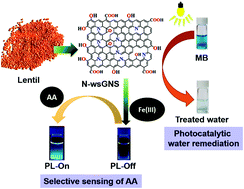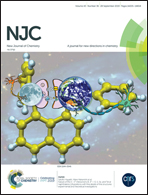Nitrogen-doped fluorescent graphene nanosheets as visible-light-driven photocatalysts for dye degradation and selective sensing of ascorbic acid†
Abstract
Nitrogen-doped soluble graphene nanosheets (N-wsGNSs) were synthesized using lentil as a natural source of carbon and nitrogen via a simple pyrolysis and oxidation approach. The as-synthesized N-wsGNSs showed remarkable fluorescence emission over the entire visible range, attributed to the high degree of surface passivation due to the introduction of oxygenated functional groups and heteroatom doping. The significant prospect of this approach is to use N-wsGNSs as multifunctional materials for photocatalytic and sensing applications. The as-synthesized N-wsGNSs exhibited high photocatalytic efficiency and could cause almost complete (∼99%) photodegradation of methylene blue (MB) within 75 min under visible light irradiation. Furthermore, a fluorescence “turn-on/-off” probe was designed for the selective sensing of ascorbic acid (AA) with a detection limit of 4 μM. The fluorescence intensity of the N-wsGNSs was selectively quenched by Fe(III) and was recovered by AA. Fe(III) served as both the fluorescence quencher for the N-wsGNSs and the selective recognizer for AA. The results highlight the broad implications of N-wsGNSs for various advanced environmental and biomedical applications.



 Please wait while we load your content...
Please wait while we load your content...